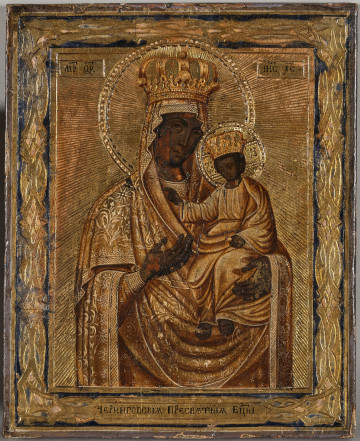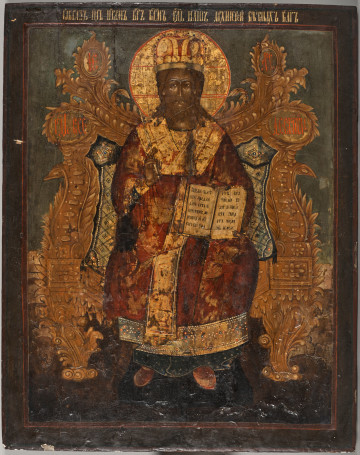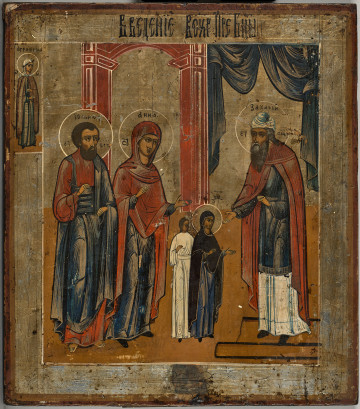
The Mother of God of Hodigitria
19th (?) century
Castle Museum in Łańcut
Part of the collection: Ikony
The tradition of depicting the Mother of God stretches back to the first centuries of Christianity. The Council of Ephesus in 341 declared the dogma of the Divine motherhood of Mary to be truth revealed, calling Her Theotokos - the Mother of God. By giving birth to the Son of God, conceived through the Holy Spirit, Mary became part of the mystery of the Incarnation of God, and thus an intermediary between Heaven and earth, a gentle guardian leading man to God. In Byzantium, the Mother of God as the intercessor of humankind was called Eleusa or Merciful - see S.12776MŁ. Over time, the name Eleusa began to be applied to those icons, in which Baby Jesus nestles against the cheek of the Theotokos and embraces her neck. In Rus, where the Marian cult flourished especially strongly, this type of depiction became known as 'Umilenie' because the Greek word 'eleos', meaning 'mercy', was also freely interpreted as affection, tenderness, grace, kindness. The presented icon is an example of an Eleusa or Umilenie depiction; it is known as Feodorovskaya Mother of God in Russian Orthodoxy. The original Feodorovskaya Eleusa, like the original Vladimir icon, is one of the earliest preserved Marian icons in the lands of Rus. Due to the significant similarity between them, researchers consider the Feodorovskaya icon to be a copy of the Theotokos of Vladimir - see S.12776MŁ; S.12850MŁ. The origins of the Feodorovskaya Eleusa are shrouded in legend which consists of several story lines intertwined with historical events and figures. A similar icon of the Mother of God was supposedly housed in the wooden belfry in Gorodets, established on the Volga in the second half of the 12th c. as a defence against the Volga Bulgars. In 1238, the settlement was burned by the Mongol-Tatar troops of Batu Khan. According to tradition, the icon of the Mother of God miraculously survived and appeared in a different place, as described under S.12808MŁ. Teresa Bagińska-Żurawska https://orcid.org/0000-0002-9243-3967
Other names
Fyodorovskaya Mother of God
Dimensions
height: 27.7 cm, width: 20.7 cm
Object type
Icons
Technique
gilding, tempera
Material
gold, tempera, wood
Origin / acquisition method
decyzja administracyjna
Creation time / dating
Creation / finding place
Owner
Castle Museum in Łańcut
Identification number
Location / status

19th (?) century
Castle Museum in Łańcut

1800 — 1850
Castle Museum in Łańcut

1800 — 1899
Castle Museum in Łańcut
DISCOVER this TOPIC
Castle Museum in Łańcut
DISCOVER this PATH
Educational path